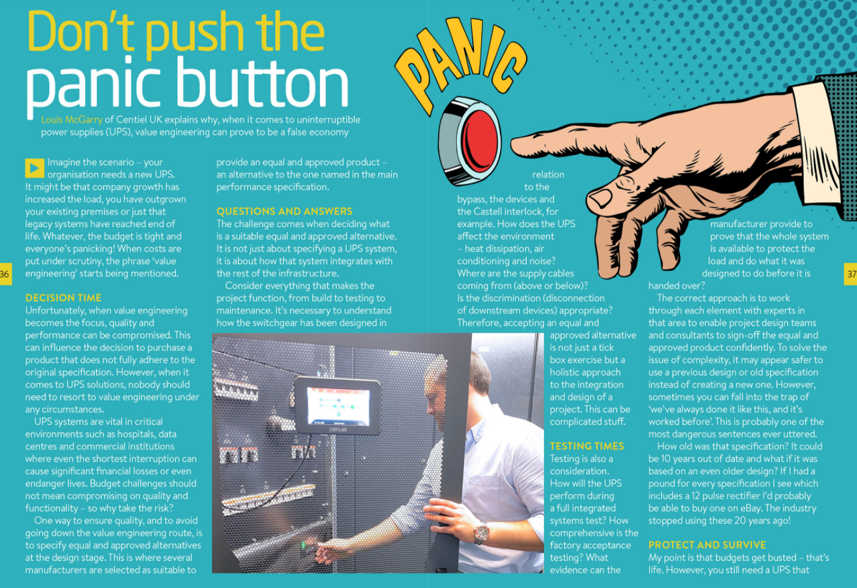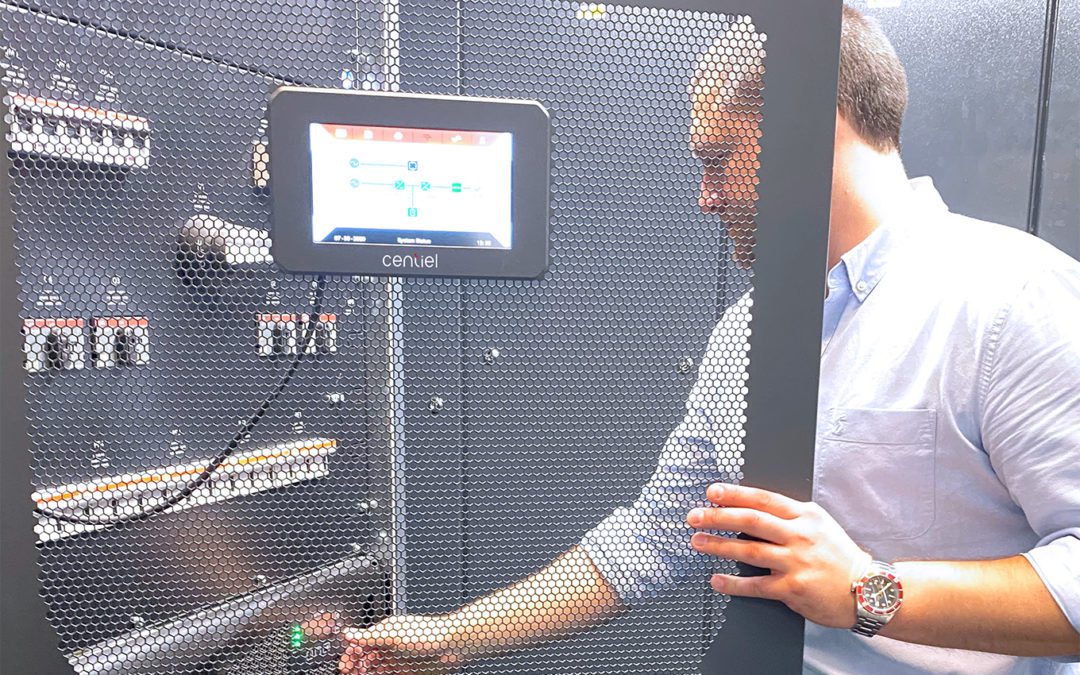Louis McGarry, Sales and Marketing Director, CENTIEL UK explains why, when it comes to uninterruptible power supplies (UPS), value engineering can prove to be false economy.
Imagine the scenario: your organisation needs a new UPS. It might be that company growth has increased the load or you have outgrown your existing premises, or just that legacy systems have reached end of life. However, the budget is tight and everyone’s panicking! When costs are put under scrutiny, the phrase ‘value engineering’ starts being mentioned.
Decision Time
Unfortunately, when value engineering becomes the focus, quality and performance can be compromised. This can influence the decision to purchase a product that does not fully adhere to the original specification. However, when it comes to UPS systems nobody should need to resort to compromising or value engineering under any circumstances.
UPS systems are vital in critical environments such as hospitals, data centres and commercial institutions where even the shortest interruption may cause significant financial losses or even endanger lives. Budget challenges should not mean compromising on quality and functionality. Why take the risk?
One way to ensure quality, and to avoid going down the value engineering route, is to specify equal and approved alternatives at the design stage. This is where several manufacturers are selected as suitable to provide an equal and approved product, alternative to the one named in the main performance specification.
Questions and Answers
The challenge comes when deciding what is a suitable equal and approved alternative. It is not just about specifying a UPS system; it is about how that system integrates with the rest of the infrastructure. Consider everything that makes the project function, from build to testing to maintenance. It’s necessary to understand how the switch gear has been designed in relation to the bypass, the devices and the Castell interlock for example. How does the UPS effect the environment: heat dissipation, air conditioning and noise? Where are the supply cables coming from (above or below)? Is the discrimination (disconnection of downstream devices) appropriate? Therefore, accepting an equal and approved alternative is not just a tick box exercise but a holistic approach to the integration and design of the project. This can be complicated stuff!
Testing Times
Testing is also a consideration. How will the UPS perform during a full-integrated systems test? How comprehensive is the factory acceptance testing? What evidence can the manufacturer provide to prove that the whole system is available to protect the load and do what it was designed to do before it is handed over?
The correct approach is to work through each element with experts in that area to enable project design teams and consultants to sign off the equal and approved product confidently. To solve the issue of complexity, it may appear safer to use a previous design or old specification instead of creating a new one. However, sometimes you can fall into the trap of “we’ve always done it like this, and it’s worked before.” This is probably one of the most dangerous sentences ever uttered!
Think: how old was that specification? It could be ten years out of date and what if it was based on an even older design? If I had a pound for every specification I see which includes a “12 Pulse Rectifier” I’d probably be able to buy one on eBay (the industry stopped using these 20 years ago!).
Protect and Survive
My point is that budgets get busted, that’s life. However, you still need a UPS which will protect the load today and one that has the capacity to be flexible and grow to do the job tomorrow. Doing what you’ve always done means being left behind as your organisation will miss out on the latest technological developments which can offer more flexibility, greater availability and reduce total cost of ownership. The right decision is an investment for the future and so it is important to understand what is really required to select a equal and approved alternative product.
Some of the complexity comes from terminology. Buzzwords and acronyms can be unhelpful! If the requirements suggest a centralised architecture, ask why? Could there be a better alternative? Ask for a comparison between the various architectures available, including features and benefits. If there is a call for ‘hot swapability’ make sure there is a clear understanding of what functionality each product provides. Hot swappable can mean a million things but really what is required is the ability to exchange modules seamlessly on a live system. It is the ability for this to be completed safely and to mitigate any human error (this is what safe-hot-swap versus hot swap actually means). This feature is only available as part of the latest technological developments. In a system without safe-hot-swap, any issue with a module going into a live system could have catastrophic consequences such as the load being lost.
Face Facts
By considering the benefits of each element of functionality using factual terminology it is possible to assess and define what the system is really required to do and why. Purchasing only what is needed at day one controls costs while maintaining the quality of the solution and no-one needs mention value engineering at all!
This ‘clever engineering’ can be best illustrated by scaling. Oversizing a UPS installation is easily done which can result in wasted CAPEX and OPEX. It’s not just the initial purchase price of an oversized system, it’s the wasted energy to run and cool the system. The maintenance and repair costs are also higher with a larger solution. Careful calculation of the actual load requirement from day one, means it is possible to reduce costs but be flexible to accommodate future growth for day two and beyond.
Designing architectures with the capacity for tomorrow but giving you the ability to implement only what you need today, reduces upfront installation costs. Scalable modular UPS systems offer a Pay As You Grow solution to those with restricted budgets. In this way you never pay for more than you need.
Fail to Plan
Another reason for people ‘doing what we’ve always done’ is fear of failure… In the past ‘you wouldn’t get fired for choosing IBM’. Maybe not, but is the best solution the one everyone’s used before? Technology moves on and better solutions become available.
To overcome this challenge (let’s face it no-one wants to get fired!) you need to work with trusted advisors. Choose those who are at the forefront of the industry and experienced in a variety of projects to develop and implement the most modern UPS solutions which maximise the benefit to organisations. In this way, the optimum solution can be determined and designed, and the ‘equal and approved alternative’ can outperform the spec and still be the most cost-effective way forward.
Talk About It
The key to the success is open and productive discussions between all parties to come up with the best long-term solution, in contrast to a knee jerk: ‘just buy the cheapest’ reaction. As trusted advisors, at CENTIEL we can help solve these common commercial challenges with equal and alternative solutions that do outperform the spec and keep the total cost of ownership down. The result is a win-win for client, consultant, and contractor alike and no-one need have a panic attack and mention value engineering ever again!
Originally featured in Inside Networks Magazine April 2021. Author: Louis McGarry



